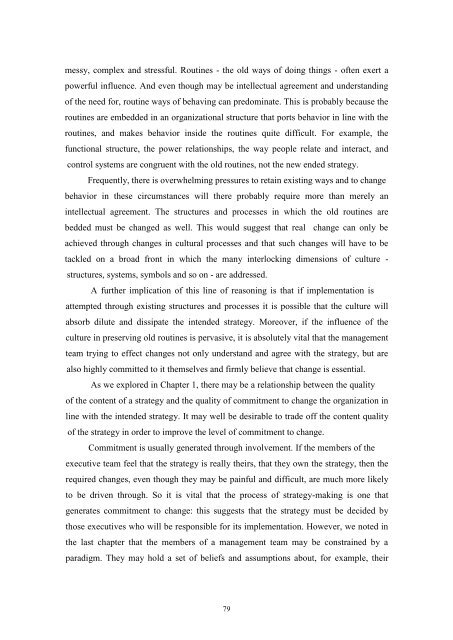DSpace at Khazar University
DSpace at Khazar University
DSpace at Khazar University
Create successful ePaper yourself
Turn your PDF publications into a flip-book with our unique Google optimized e-Paper software.
messy, complex and stressful. Routines - the old ways of doing things - often exert a<br />
powerful influence. And even though may be intellectual agreement and understanding<br />
of the need for, routine ways of behaving can predomin<strong>at</strong>e. This is probably because the<br />
routines are embedded in an organiz<strong>at</strong>ional structure th<strong>at</strong> ports behavior in line with the<br />
routines, and makes behavior inside the routines quite difficult. For example, the<br />
functional structure, the power rel<strong>at</strong>ionships, the way people rel<strong>at</strong>e and interact, and<br />
control systems are congruent with the old routines, not the new ended str<strong>at</strong>egy.<br />
Frequently, there is overwhelming pressures to retain existing ways and to change<br />
behavior in these circumstances will there probably require more than merely an<br />
intellectual agreement. The structures and processes in which the old routines are<br />
bedded must be changed as well. This would suggest th<strong>at</strong> real change can only be<br />
achieved through changes in cultural processes and th<strong>at</strong> such changes will have to be<br />
tackled on a broad front in which the many interlocking dimensions of culture -<br />
structures, systems, symbols and so on - are addressed.<br />
A further implic<strong>at</strong>ion of this line of reasoning is th<strong>at</strong> if implement<strong>at</strong>ion is<br />
<strong>at</strong>tempted through existing structures and processes it is possible th<strong>at</strong> the culture will<br />
absorb dilute and dissip<strong>at</strong>e the intended str<strong>at</strong>egy. Moreover, if the influence of the<br />
culture in preserving old routines is pervasive, it is absolutely vital th<strong>at</strong> the management<br />
team trying to effect changes not only understand and agree with the str<strong>at</strong>egy, but are<br />
also highly committed to it themselves and firmly believe th<strong>at</strong> change is essential.<br />
As we explored in Chapter 1, there may be a rel<strong>at</strong>ionship between the quality<br />
of the content of a str<strong>at</strong>egy and the quality of commitment to change the organiz<strong>at</strong>ion in<br />
line with the intended str<strong>at</strong>egy. It may well be desirable to trade off the content quality<br />
of the str<strong>at</strong>egy in order to improve the level of commitment to change.<br />
Commitment is usually gener<strong>at</strong>ed through involvement. If the members of the<br />
executive team feel th<strong>at</strong> the str<strong>at</strong>egy is really theirs, th<strong>at</strong> they own the str<strong>at</strong>egy, then the<br />
required changes, even though they may be painful and difficult, are much more likely<br />
to be driven through. So it is vital th<strong>at</strong> the process of str<strong>at</strong>egy-making is one th<strong>at</strong><br />
gener<strong>at</strong>es commitment to change: this suggests th<strong>at</strong> the str<strong>at</strong>egy must be decided by<br />
those executives who will be responsible for its implement<strong>at</strong>ion. However, we noted in<br />
the last chapter th<strong>at</strong> the members of a management team may be constrained by a<br />
paradigm. They may hold a set of beliefs and assumptions about, for example, their<br />
79

















